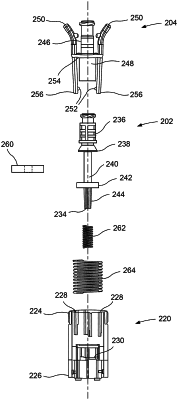| CPC A61B 17/3423 (2013.01) [A61B 17/00234 (2013.01); A61B 2017/00296 (2013.01)] | 16 Claims |

|
1. A device, comprising:
a flexible access cannula including a lumen extending therethrough, the flexible access cannula being sized and shaped to extend through a flexible endoscopic shaft to a target tissue within a living body;
a puncturing element sized and shaped to extend through the lumen of the access cannula and distally out a distal end of the access cannula;
a handle including a handle body and an advancement mechanism configured to advance the access cannula from a proximal position relative to the puncturing element, where a puncturing tip of the puncturing element is exposed distal to a distal end of the access cannula, to a distal position relative to the puncturing element, where the distal end of the access cannula covers the puncturing tip of the puncturing element;
a rotation hub fixed to the access cannula and coupled to a proximal end of the handle body, the rotation hub being rotatable relative to the handle body and slidable a second predetermined distance relative to the handle body; and
a cap fixed to the puncturing element and couplable to the rotation hub wherein, when the cap and the rotation hub are coupled, the puncturing tip extends a first predetermined distance relative to the distal end of the access cannula,
wherein the proximal end of the handle body includes an end cap into which a distal portion of the rotation hub is inserted to couple the rotation hub to the handle body, the end cap having a seat against which a first spring is positioned, and
wherein the rotation hub includes a first proximal flange and a second distal flange with a shaft extending therebetween, the shaft having a washer and a second spring slidable thereover and constrained between the first and second flanges.
|